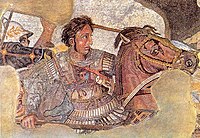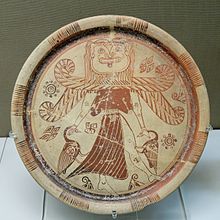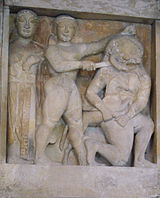Gorgons

| Part of a series on |
| Greek mythology |
|---|
 |
| Deities |
| Heroes and heroism |
| Related |
|
|
In Greek mythology, the Gorgon (plural: Gorgons) (Greek: Γοργών or Γοργώ Gorgon/Gorgo) was the most famous daemon , a terrifying female creature, whose name derives from the Greek word gorgós, which means "dreadful." Her head is represented in the Iliad as fixed in the centre of the aegis of Zeus. The Gorgo Aix (αίγα: aega, goat) was an ancient Gorgon slain by Zeus at the start of the Titan war. He made his famous aegis cape from her skin--a goatish-hide rimmed with serpents--and placed her terrifying visage upon it. [1] The Gorgoneion (Greek: Γοργόνειον) was a special apotropaic amulet showing the Gorgon's head, and it is possible that it originates from terrifying masks of primitive cultures.[2]
The poet Hesiod seems to have imagined the Gorgones as reef-creating sea-daemons, personifications of the deadly submerged reefs which posed such a danger to ancient mariners. The term commonly refers to any of the three sisters, daughters of the sea monster Phorkys ( άλιος γέρων : "old man of the sea" ) and the earth goddess Gaia [3]They had hair of living, venomous snakes, and a horrifying visage that turned those who beheld it to stone. Traditionally, while two of the Gorgons were immortal, Stheno and Euryale, their sister Medusa was not, and was slain by the mythical demigod and hero Perseus, who added the Gorgoneion to the aegis, as a votive gift [4]
Gorgons were a popular image of Greek mythology. Hybrid creatures and daemons appear in the Babylonian and Egyptian religion, and also in Minoan Crete, where the daemons were part of the religious system and a sea-goddess with a monstrous head is depicted . [5] In the earliest Greek depictions the images of the Gorgons are related with the Minoan Potnia Theron ( "The Mistress of the Animals") who is identified with Artemis. In Arcadia, Demeter was worshiped in her archaic form ,a Medusa type with a horse's head with snaky hair, holding a dove and a dolphin, which are symbols of the Minoan Great Goddess.[6] Because of their legendary gaze, images of the Gorgons were put upon objects and buildings for protection. An image of a Gorgon holds the primary location at the pediment of the temple of Artemis at Corfu. It is the oldest stone pediment in Greece and is dated to c. 600 BC.
In Greek folklore the Gorgon (γοργόνα) is a mermaid, a mythological aquatic creature with a female human head, arms, and torso and the tail of a fish. She is a mixture of the myths of the Gorgons, Seirenes, and the relative Assyrian myths.
Origins

The concept of the Gorgon is at least as old in mythology as Perseus and Zeus. The name is Greek, being derived from "gorgos" and translating as terrible or dreadful.
Author Marija Gimbutas (Language of the Goddess) believed she saw the prototype of the Gorgoneion in Neolithic art motifs, especially in anthropomorphic vases and terracotta masks inlaid with gold.
A female figure, probably a sea-goddess is depicted on a Minoan gold ring from the island Mochlos in Crete. The goddess has a monstrous head, and she is sitting in a boat. A holy tree is depicted, probably related with the Minoan cult of the tree. [7]
The large eyes, as well as Athena's "flashing" eyes, are symbols termed "the divine eyes" by Gimbutas (who did not originate the perception), appearing also in Athena's bird, the owl. They can be represented by spirals, wheels, concentric circles, swastikas, firewheels, and other images.
The fangs of the Gorgons are those of snakes and are likely derived from the guardians closely associated with early Greek religious concepts at the centers of oracles. In some cruder representations , blood flowing under the head of the Gorgon has been mistaken for a beard or wings.
Other possible origins have been suggested from similarities of the Babylonian creature Humbaba in the Gilgamesh epic.
Classical tradition



Gorgons are sometimes depicted as having wings of gold, brazen claws, the tusks of boars, but most often with the fangs and skin of a serpent. The oldest oracles were said to be protected by serpents and a Gorgon image was often associated with those temples. Lionesses or sphinxes are frequently associated with the Gorgon as well. The powerful image of the Gorgon was adopted for the classical images and myths of Zeus and Athena, perhaps being worn in continuation of a more ancient imagery. The Gorgons were said to be the daughters of the sea god Phorcys and his sister-wife, Ceto the sea monster.
Homer, the author of the oldest known work of European literature, speaks only of one Gorgon, whose head is represented in the Iliad as fixed in the centre of the aegis of Zeus:
- "About her shoulders she flung the tasselled aegis, fraught with terror...and therein is the head of the dread monster, the Gorgon, dread and awful, a portent of Zeus that beareth the aegis."(5.735ff)
Its earthly counterpart is a device on the shield of Agamemnon:
- "...and therein was set as a crown the Gorgon, grim of aspect, glaring terribly, and about her were Terror and Rout."(11.35ff)

The date of Homer was controversial in antiquity, and is no less so today. Herodotus said that Homer lived 400 years before his own day, which would place Homer about 850 BC;[8] but other ancient sources gave dates much closer to the Trojan War. [9] Those who believe that the stories of the Trojan War derive from a specific historical conflict usually date it to the twelfth or eleventh centuries BC, often preferring the dates given by Eratosthenes, 1194–1184 BC, which roughly corresponds with archaeological evidence of a catastrophic burning of Troy VIIa. For modern scholarship, 'the date of Homer' refers to the date of the poems as much as to the lifetime of an individual.
The scholarly consensus is that "the Iliad and the Odyssey date from the extreme end of the ninth century BC or from the eighth, the Iliad being anterior to the Odyssey, perhaps by some decades."[10] They are presumed to have existed as an oral tradition that eventually became set in historical records. Even at that early time the Gorgon is displayed as a vestige of ancient powers that preceded the historical transition to the beliefs of the Classical Greeks, displayed on the chest of Athene and Zeus.
In the Odyssey, the Gorgon is a monster of the underworld to which the earliest deities were cast:
- "...and pale fear seized me, lest august Persephone might send forth upon me from out of the house of Hades the head of the Gorgon, that awful monster..."(11.635)
Around 700 BC, Hesiod (Theogony, Shield of Heracles) increases the number of Gorgons to three—Stheno (the mighty), Euryale (the far-springer), and Medusa (the queen), and makes them the daughters of the sea-god Phorcys and of Keto. Their home is on the farthest side of the western ocean; according to later authorities, in Libya. Ancient Libya is identified as a possible source of the deity, Neith, who was called Athene in Greece.
The Attic tradition, reproduced in Euripides (Ion), regarded the Gorgon as a monster, produced by Gaia to aid her children, the Titans, against the new Olympian deities and she was slain by Athena, who wore her skin thereafter. Of the three Gorgons, only Medusa is mortal.

The Bibliotheca (2.2.6, 2.4.1, 2.4.2) provides a good summary of the Gorgon myth. Much later stories claim that each of three Gorgon sisters, Stheno, Euryale, and Medusa, had snakes for hair, and that they had the power to turn anyone who looked at them to stone.
According to Ovid (Metamorphoses), a Roman poet writing in 8 AD who was noted for accuracy regarding the Greek myths, Medusa alone had serpents in her hair, and that this was due to Athena (Roman Minerva) cursing her. Medusa had copulated with Poseidon (Roman Neptune) in a temple of Athena after he was aroused by the golden color of Medusa's hair. Athena therefore changed the enticing golden locks into serpents. Diodorus and Palaephatus mention that the Gorgons lived in the Gorgades, islands in the Aethiopian Sea. The main island was called Cerna and, according to Henry T. Riley, these islands may correspond to Cape Verde.[11]
It is mentioned that the Gorgons lived in the entrance of the Underworld in the Aenid.
Pausanias (5.10.4, 8.47.5, many other places), a geographer of the second century A.D., supplies the details of where and how the Gorgons were represented in Greek art and architecture.
Perseus and Medusa

In later myths, Medusa was the only one of the three Gorgons who was not immortal. King Polydectes sent Perseus to kill Medusa in hopes of getting him out of the way, while he pursued Perseus's mother, Danae.
Some authors say that Perseus was armed with a scythe from Hermes (Roman equivalent Mercury) and a mirror (or a shield) from Athena. Perseus could safely cut off Medusa's head without turning to stone by looking only at her reflection in the shield. From the blood that spurted from her neck and jumping into the sea sprang Pegasus and Chrysaor, her sons by Poseidon. Other sources say that each drop of blood became a snake. He gave the head, which retained the power of turning into stone all who looked upon it, to Athena. She then placed it on the mirrored shield called Aegis and gave it to Zeus. Another source says that Perseus buried the head in the marketplace of Argos.
According to other accounts, either he or Athena used the head to turn Atlas into stone, transforming him into the Atlas Mountains that held up both heaven and earth.[12] He also used it against a competing suitor.
Ultimately, he used it against King Polydectes. When Perseus returned to the court of the king, Polydectes asked if he had the head of Medusa. Perseus replied "here it is" and held it aloft, turning the whole court to stone.
Protective and healing powers

In Ancient Greece a Gorgoneion (or stone head, engraving, or drawing of a Gorgon face, often with snakes protruding wildly and the tongue sticking out between her fangs) frequently was used as an apotropaic symbol [13] and placed on doors, walls, floors, coins, shields, breastplates, and tombstones in the hopes of warding off evil. In this regard Gorgoneia are similar to the sometimes grotesque faces on Chinese soldiers’ shields, also used generally as an amulet, a protection against the evil eye. Likewise, in Hindu Mythology, Kali is often shown with a protruding tongue and snakes around her head.

In Greek mythology, blood taken from the right side of a Gorgon could bring the dead back to life, yet blood taken from the left side was an instantly fatal poison. Athena gave a vial of the healing blood to Asclepius, which ultimately brought about his demise. Heracles is said to have obtained a lock of Medusa’s hair (which possessed the same powers as the head) from Athena and to have given it to Sterope, the daughter of Cepheus, as a protection for the town of Tegea against attack. According to the later idea of Medusa as a beautiful maiden, whose hair had been changed into snakes by Athena, the head was represented in works of art with a wonderfully handsome face, wrapped in the calm repose of death.
Cultural depictions of Gorgons
Gorgons, especially Medusa, have been a common image and symbol in Western culture since their origins in Greek Mythology, appearing in art, literature and elsewhere throughout history.
References
- ^ Theoi project, Gorgo Aix [htpp://www.theoi.com/Titan/GorgoAix.html]
- ^ Harrison, Jane Ellen (1991). Prolegomena to the Study of Greek Religion. Princeton University Press. ISBN 0691015147.
{{cite book}}: Invalid|ref=harv(help) pp.187,188 - ^ Theoi Project: Gorgones [htpp://www.theoi.com/Pontios/Gorgones.html]
- ^ As in Kerenyi 1951:50
- ^ M.Nilsson(1967), Vol I, pp.294-297
- ^ L. H. Jeffery (1976). Archaic Greece: The Greek city states c.800-500 B.C (Ernest Benn Limited) p 23 ISBN 0-510-03271-0
- ^ Martin Nilsson (1967), Die Geschichte der Griechischen Religion Vol I. C.F. Beck Verlag, Muenchen p. 246
- ^ Herodotus 2.53.
- ^ Barbara Graziosi, The Invention of Homer (Cambridge 2002) 98–101.
- ^ Pierre Vidal-Naquet, Le monde d'Homère, Perrin 2000, p19
- ^ Ovid, The Metamorphoses, commented by Henry T. Riley ISBN 13 978-1420933956
- ^ Polyeidos, Fragment 837; Ovid, Metamorphoses 4.627
- ^ Garber, Marjorie. The Medusa Reader, 24 February 2003, Introduction, pg. 2, ISBN 0-415-90099-9.
This article incorporates text from a publication now in the public domain: Chisholm, Hugh, ed. (1911). Encyclopædia Britannica (11th ed.). Cambridge University Press. {{cite encyclopedia}}: Missing or empty |title= (help)
Additional material has been added from the 1824 Lemprière's Classical Dictionary.
External links
- F. T. Elworthy. "s:Folk-Lore/Volume 14/A Solution of the Gorgon Myth" Folk-Lore. Volume 14 (1903).
